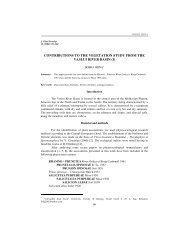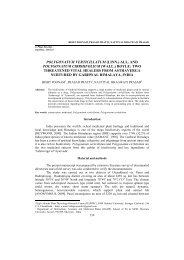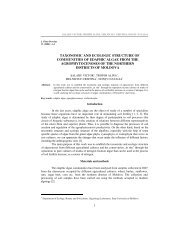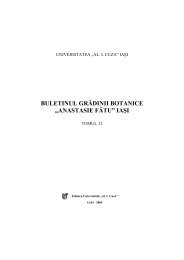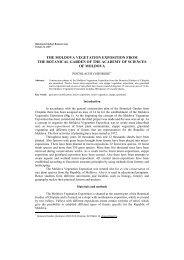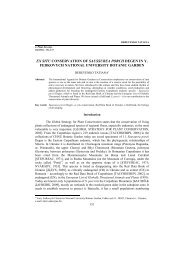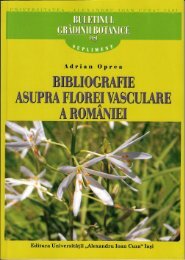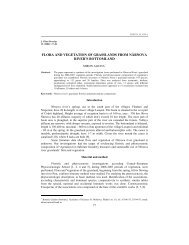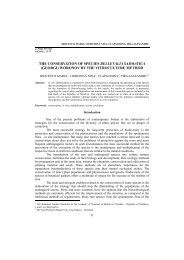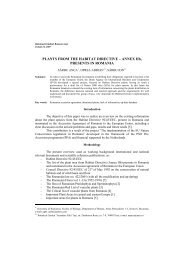importance of mushroom colections used for mycology knowledge
importance of mushroom colections used for mycology knowledge
importance of mushroom colections used for mycology knowledge
Create successful ePaper yourself
Turn your PDF publications into a flip-book with our unique Google optimized e-Paper software.
IMPORTANCE OF FUNGAL COLLECTIONS FOR MYCOLOGY IN THE FRAME OF …<br />
In USA, the most important collection was recognized by ATCC (American Type<br />
Culture Collection), founded in 1925. The predecessor <strong>of</strong> this collection was founded in<br />
1899 by American Society <strong>of</strong> Bacteriology.<br />
In Asia, one <strong>of</strong> the most famous collection <strong>of</strong> fungi are: GBCC (Gene Bank<br />
Culture Collection), Genes Bank from Tsukuba (Japan) and IFO Collection from Institute<br />
<strong>of</strong> Fermentation (Osaka, Japan).<br />
The actual collections <strong>of</strong> microorganism cultures are assisted and supervised by<br />
specific s<strong>of</strong>tware [CONSTANTINESCU & MOBERG, 1987 etc.]. Table 1 presenting the<br />
main collections recognized around the world.<br />
Tab. 1. Culture collections <strong>of</strong> fungi recognized around the world<br />
(based on http://biodiversity.bio.uno.edu/~fungi/fcollect.html)<br />
Nr.<br />
Collections<br />
Abbreviation<br />
Organisms etc.<br />
crt. (in alphabetical order)<br />
1 2 3 4<br />
1. Agricultural Research Service NRRL Penicillium; Aspergillus;<br />
Culture Collection (Peoria, IL,<br />
Actinomycetes<br />
USA)<br />
2. American Type Culture Collection ATTC Filamentous fungi; Yeasts<br />
3. ARS Collections <strong>of</strong> ARSEF Entomophageous fungi<br />
Entomopahtogenic Fungi (USDA–<br />
ARS) (Ithaca NY, USA)<br />
4. Banque Européennes des Glomales BEG Micorrhyzant fungi from<br />
Glomales phylum <strong>for</strong> Europe<br />
5. Belgian Co-ordinated Collections <strong>of</strong> BCCM fungi; yeasts; bacteria;<br />
Microorganisms<br />
6. CABRI – Common Access to<br />
Biological Resources and<br />
In<strong>for</strong>mation<br />
7. Canadian Collection <strong>of</strong> Fungal<br />
Culture<br />
CABRI<br />
CCFC<br />
plasmids<br />
European Collections<br />
(BCCM, CABI, CBS)<br />
Over 10.000 fungi collections<br />
8. Centraalbureau voor CBS Filamentous fungi, yeasts,<br />
Schimmelcultures – The<br />
bacteria, actinomycetes,<br />
Netherlands<br />
Aphyllophorales, Fusarium,<br />
anamorphous-telemorphous<br />
9. Culture Collection <strong>of</strong> CCBAS Over 630 isolated fungi from 253<br />
Basidiomycetes (Czech Republic)<br />
spp. from 115 species <strong>of</strong><br />
Agaricales, Aphyllophorales and<br />
Gasterales.<br />
10. Czech Collection <strong>of</strong> Fungi CCF ~ 2000 isolated fungi<br />
11. Fungal Cultures, University <strong>of</strong><br />
Göteborg – Sweden<br />
FCUB<br />
Especially lignicol fungi<br />
12. Fungal Genetics Stock Centre<br />
(U.K. mirror site)<br />
FGSC Aspergillus; Fusarium;<br />
Neurospora; Sordaria; wild and<br />
mutants types; cloned genes;<br />
genes bank<br />
114



